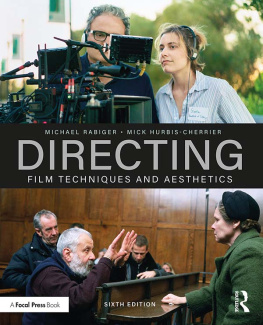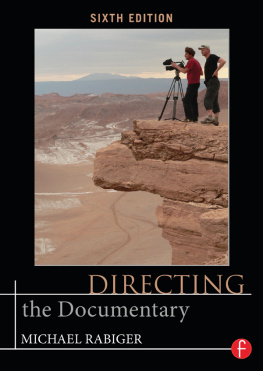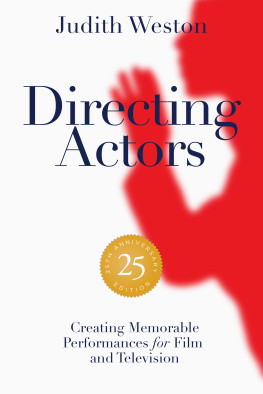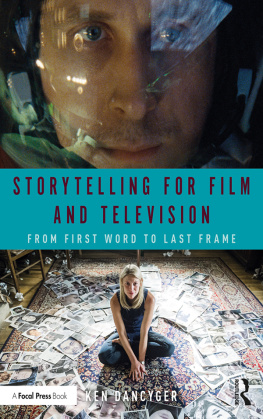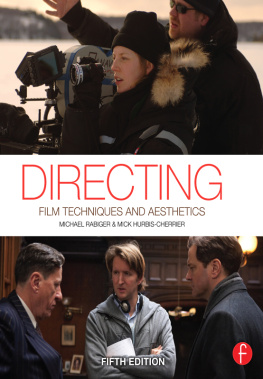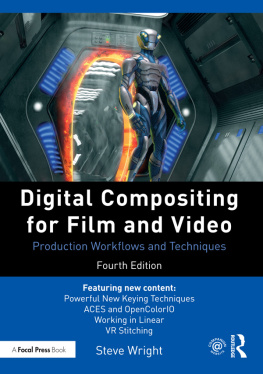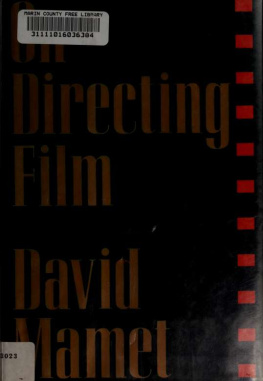DIRECTING
Directing: Film Techniques and Aesthetics is a comprehensive exploration into the art and craft of directing for film and television. Its filled with practical advice, essential technical information, and inspiring case studies for every stage of production. This book covers the methods, technologies, thought processes, and judgments that a director must use throughout the fascinating process of making a film, and concentrates on developing the human aspects of cinema to connect with audiences.
The fully revised and updated 6th edition features new sections on using improvisation, the development of characters for long form television series, visual design, the role of the digital imaging technician, film promotion and distribution, alongside expanded information on contemporary color grading tools, stylistic approaches and genre, workflows, blocking scenes for the camera and more. The book emphasizes independent and short form cinema which allows cutting-edge creativity and professionalism on shoestring budgets. Recognizing that you learn best by doing, it includes dozens of practical hands-on projects and activities to help you master technical and conceptual skills.
Just as important as surmounting technological hurdles is the conceptual and authorial side of filmmaking. This book provides an unusually clear view of the artistic process, particularly in working with actors and principle crew members. It offers eminently practical tools and exercises to help you develop your artistic identity, find credible and compelling stories, choose and work with your cast, and hone your narrative skills. Directing shows you how to surpass mere technical proficiency and become a storyteller with a distinctive voice and style.
The accompanying companion website includes film analysis exercises, shooting projects, checklists and assignment forms, analytical questionnaires, updated production forms and logs for all phases of a project with links to additional resources and set safety advice.
Michael Rabiger has directed or edited over 35 films, was a founding faculty member and then Chair of the Film/Video Department at Columbia College Chicago, and has given workshops in over 23 countries. He is an Honorary Professor at Buenos Aires University, and a Fulbright Specialist. Rabiger is also the author of Developing Story Ideas and the enormously successful Directing the Documentary, both for Routledge/Focal Press.
Mick Hurbis-Cherrier teaches filmmaking at Hunter College in New York City. Professionally, he has worked as a screenwriter, director, cinematographer, and editor, and his films have garnered prizes at numerous festivals. He is the author of Voice & Vision: A Creative Approach to Filmmaking (Routledge/Focal Press), in its third edition.
DIRECTING
FILM TECHNIQUES AND AESTHETICS
Sixth Edition
Michael Rabiger and Mick Hurbis-Cherrier
Illustrated by Gustavo Mercado

Sixth edition published 2020
by Routledge
2 Park Square, Milton Park, Abingdon, Oxon, OX14 4RN
and by Routledge
52 Vanderbilt Avenue, New York, NY 10017
Routledge is an imprint of the Taylor & Francis Group, an informa business
2020 Michael Rabiger, Mick Hurbis-Cherrier
The right of Michael Rabiger and Mick Hurbis-Cherrier to be identified as authors of this work has been asserted by them in accordance with sections 77 and 78 of the Copyright, Designs and Patents Act 1988.
All rights reserved. No part of this book may be reprinted or reproduced or utilised in any form or by any electronic, mechanical, or other means, now known or hereafter invented, including photocopying and recording, or in any information storage or retrieval system, without permission in writing from the publishers.
Trademark notice: Product or corporate names may be trademarks or registered trademarks, and are used only for identification and explanation without intent to infringe.
Fifth edition published by Routledge 2013
British Library Cataloguing-in-Publication Data
A catalogue record for this book is available from the British Library
Library of Congress Cataloging-in-Publication Data
A catalog record has been requested for this book
ISBN: 978-0-8153-9430-3 (hbk)
ISBN: 978-0-8153-9431-0 (pbk)
ISBN: 978-1-351-18639-1 (ebk)
Typeset in Sabon
by Servis Filmsetting Ltd, Stockport, Cheshire
Visit the companion website: www.routledge.com/cw/rabiger
M. Rabiger
To Lewis, Netta, Alma, Helena, Elliot, Lauren, Freya, Jessica,
Olivia, and their terrific parents with love and gratitude.
M. Hurbis-Cherrier
To my dear colleagues, friends, and mentors,
Jay Roman and Joel Zuker.
CONTENTS
Telling stories through the screen is tomorrows literacy. Everyone will eventually need skills in this intensely human, collaborative artformbe they young or old. If directing already calls to you, its because you are a film student; media teacher; photographer seeking broader skills; film technician ready to direct; or a beginner intent on self-education with friends as collaborators. Whoever you are, here is your step-by-step guide. It is written in everyday language by cinema enthusiasts informed by many decades of filmmaking and teaching.
Directing: Film Techniques and Aesthetics explains everything the director must know about the technical and conceptual areas. Like no other manual, it shares the intimate thought processes, feelings, and judgments so important to liberating the screen author in you, to finding your own themes, and to developing stories for audiences. It shows how to work with actors and cinema technicians to tell your stories in your way. This is not vanity or egotism; its the rocky road to making cinema art, the longtime ultimate in entertainment and human communication.
We know people learn best from doing, so we treat you as a colleague ready to start shooting short fiction immediatelyusing nothing more than your smartphone, if need be. Theres a range of hands-on projects from the ground upward, each designed to make learning practical, enjoyable, and illuminating. We have also provided for different learning styles: some like to read first then do a project to consolidate their understanding; others do the projects, then read the relevant text after hitting interesting bumps in the road. However you proceed, cost no longer blocks your path since cameras and computers are everywhere. Start building your experience at storytelling, and solve artistic and technical difficulties as they occur: its a guerrilla approach that sees problems and difficulties as intrinsic to learning.
Like no other book on directing, we explain the entire spectrum of skills, not just the technological. Using analogies and self-investigation exercises and encouraging mentorship, we guide you the entire way through the portals of self-expression. Making films that embody your artistic voice and identity wont ever be easy, but it will engage your heart, hands, and mind from the beginning. This book takes you deep into the professional experience, which is nothing less than the artistic experience lived by filmmakers. With the explosion of distribution on the Internet, this book opens the door to many new career possibilities.
WHATS NEW
This, the 6th edition, introduces what the director must know about new trends, techniques, and terminology. It teaches equipment principles rather than the fast-changing particularities covered more accessibly as online texts and tutorials. Here is the core knowledge you wont find elsewhere: the human, psychological, and embracing technical grasp that every good director needs.

